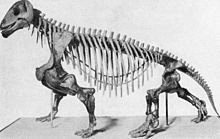Titanosuchia
| Titanosuchia | ||||||||||||
|---|---|---|---|---|---|---|---|---|---|---|---|---|

|
||||||||||||
| Temporal occurrence | ||||||||||||
| Middle Perm to Upper Perm | ||||||||||||
| 272.5 to 251 million years | ||||||||||||
| Locations | ||||||||||||
| Systematics | ||||||||||||
|
||||||||||||
| Scientific name | ||||||||||||
| Titanosuchia | ||||||||||||

The Titanosuchia ( Syn .: Tapinocephalia ) were land vertebrates from the group of Therapsiden ("mammal-like reptiles").
features
Titanosuchia were large, heavily built animals and the dominant terrestrial vertebrates of the South African Tapinocephalus fauna. They adapted to a herbivorous diet, which was evident in the reduction in canine teeth, enlargement of the incisor base, and an increase in molars up to twenty. The temporomandibular joint moved forward so that the jaw was shorter than that of the Brithopia . The skull bones became much thicker. The postcranial skeleton (the area of the skeleton following the skull) showed adaptations to a high body weight. The vertebrae were short and wide, the shoulder girdle was massive, the humerus , radius and ulna were large with flattened ends, the bones of the hind legs were wide, the pelvis was short but wide. The phalangeal formula is 2-3-3-3-3, as in mammals , but evolved independently from them. The paleontologist Thomas Kemp suspected in 1982 that the front legs were still held in a splayed position, while the rear legs were already more vertically under the body. In view of the size of the Titanosuchia, however, a leg posture is also conceivable, in which a vertical position under the body is mandatory.
Systematics
The Titanosuchia are - besides the Brithopia - the second, more advanced group of the Dinocephalia ("animals with terrible skulls") within the Therapsids .
Families and genera
- Styracocephalidae
- Tapinocephalidae
- Titanosuchidae
literature
- Thomas S. Kemp: The Origin & Evolution of Mammals. Oxford University Press, Oxford 2005. ISBN 0198507615 .